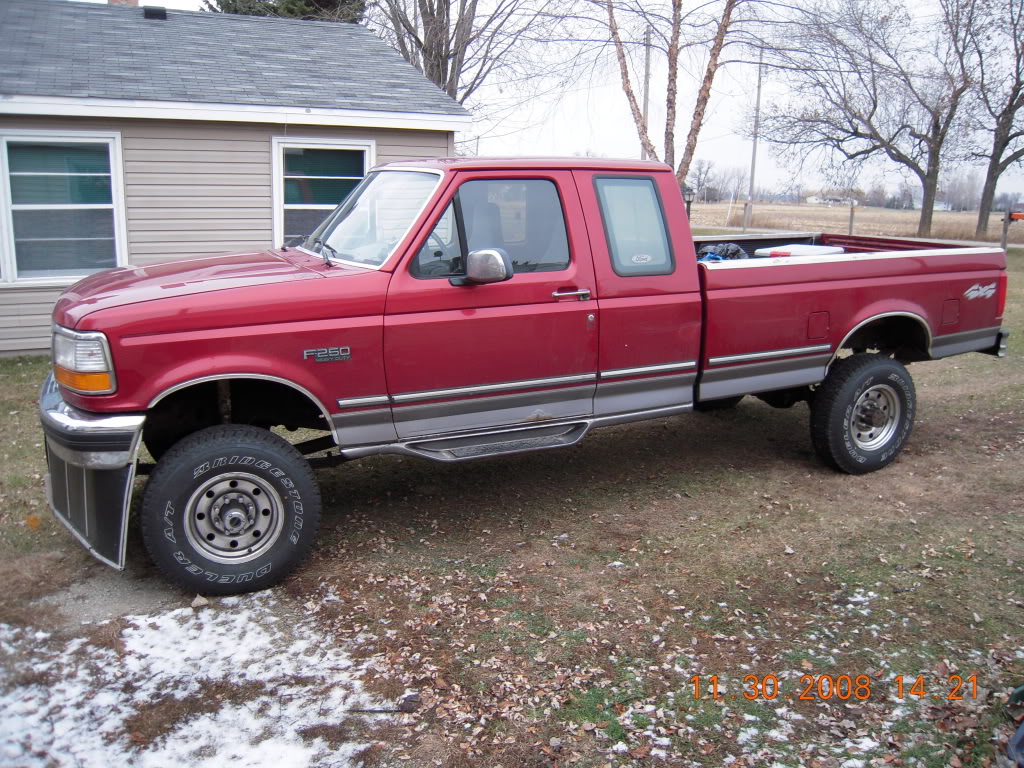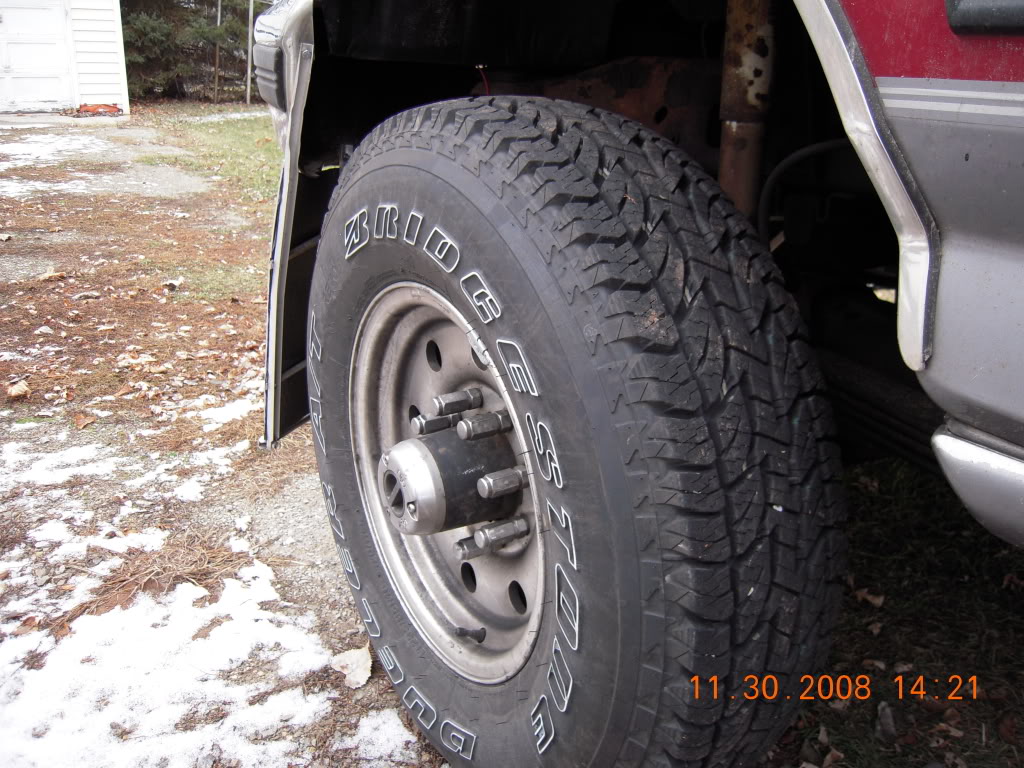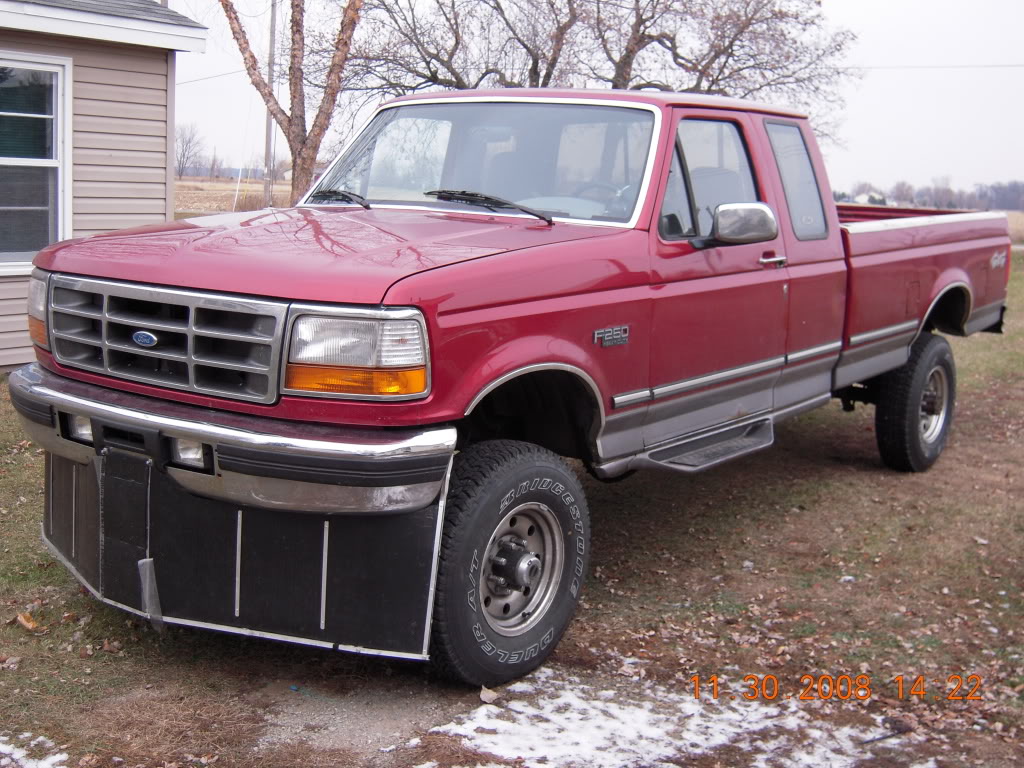 |
|
 11-30-2008, 12:12 PM
11-30-2008, 12:12 PM
|
#1
|
|
Registered Member
Join Date: Mar 2008
Posts: 75
Country: United States
|
New tires are on!
I got my new tires mounted and balanced on my F250 truck. I noticed a huge difference in coasting and on my vac. gauge. My MPG jumped into the 14's  even in these freezing winter temps. I bought Bridgestone Dueler A/T Revo's. They are the stock E rated 235/85R16's, my old ones were D rated 285/75R16's. Here's some pics:



EDIT: I almost forgot, I have them at 80 PSI - sidewall max.
__________________


|

|

|
 11-30-2008, 12:19 PM
11-30-2008, 12:19 PM
|
#2
|
|
Registered Member
Join Date: Dec 2007
Posts: 529
Country: United States
|
Did you check the manufacturers' actual listed tire size to compare your actual circumfirences? GPS data for actual speed?
I'm potentially looking to do a swap of my 285/75R16's to an E rated 235/85 or a 265/75 myself, so I'll be watching. 
Looks like the Revo 285/75 does 631 turns per mile and the Revo 235/85 does 648.
__________________
Dave
|

|

|
 11-30-2008, 12:51 PM
11-30-2008, 12:51 PM
|
#3
|
|
Registered Member
Join Date: Mar 2008
Posts: 75
Country: United States
|
I didn't check out any of that info, I figured there would be some difference though. I was going to measure the circumference of the old ones compared to the new ones, but I ran out of time. My old tires were basically bald and looked about the same height when they stood next to each other. Another factor that didn't help with my old tires, was that one of them was the spare on the rear axle. Its a stock size, but looks smaller than these new tires. The rear axle has clutches in it for positrac, which are mostly burned out. I do have a gps that I can compare speed with, I'll have to try that out.
__________________


|

|

|
 11-30-2008, 01:27 PM
11-30-2008, 01:27 PM
|
#4
|
|
Registered Member
Join Date: Dec 2007
Posts: 529
Country: United States
|
I know my PSD '96 E350 used a VSS to calculate data for the speedometer.
I'm not sure if yours would have it, but you could try this.
Hold down the odometer reset button with the key off, then turn on the vehicle without starting. There might be a number there that you scroll to using the reset button.
If you have that, it can be reset to work with the actual tire size that you have.
Quote:
There is no tire size/code chart because tire size vs. actual tire dimensions are different between manufacturers. Even between the same tire size and same maker there will be a difference in actual size between the different tread designs.
The Ford calibration equation is:
20186 / tire height in inches = some number, then: some number /.6666 = program code
Example:
Start with 20186, divide by actual tire size in inches. Divide again by .6666
You want to use a rolling measurement to get your actual tire height (If you try to measure the tire in the driveway, use conversion charts, or anything else you will end up with an inaccurate reading again). Use your rear tire since the sensor is located there. Mark the ground and your tire and roll forward 3 times marking the ground each time. (I ran over a spot of oil at a local gas station and measured between my tread mark prints), then divide that number by three to get the average length of one revolution (this will protect yourself against a bad reading using just one revolution). You can then divide the length of one revolution by 3.14 to get actual tire height. Be careful in your measurements, a small amount will change the code. EX: 31.69" tire height is code 956, and 31.21" tire height is code 970.
Now, to program it into your truck:
Warning: You can only change the calibration 6 times without replacing the module.
To set the calibration, ground the single wire connector under the glove box it says PSOM (Programable Speedometer Opdometer Module). ?Yes there is only one and it has a spade type plug on the end". I used a wire with clips on both ends to ground the plug to a screw under the dash or try a test light and use the clip end to the PSOM and the other jam in a dooe hinge. Now look at your speedometer on the face of your dash while sitting in the drivers seat and there should be a "reset" button and a "select" button. While holding the reset button in on the trip meter, turn the ignition to 'on' while the wire is still grounded. Let go of the reset button. The speedometer display will sweep once and will show a code of some kind then push in again the "reset" button and the existing code will be displayed with RECAL?, mine said 976 RECAL? Now you enter your new code you came up with by dividing the rolling measurement by PI or 3.14 by pushing the "select" button until it gets to the new calibration code number. You may have to push ?select? a whole bunch of times until you get to your code. If you turn off the key at this point the original code will not be changed or any of the 6 lives will not be used. To store your new code press ?Reset?. Turn off the key. Unplug the ground wire. To check the new calibration, use the mile markers on the interstate. Run an indicated 60 mph and it should take exactly 60 seconds to go 1 mile.
|
__________________
Dave
|

|

|
 11-30-2008, 05:42 PM
11-30-2008, 05:42 PM
|
#5
|
|
Registered Member
Join Date: Nov 2006
Posts: 1,027
Country: United States
|
Holycow has a great link in his signature for calculating the speedometer correction: http://miata.net/garage/tirecalc.html
|

|

|
 11-30-2008, 07:04 PM
11-30-2008, 07:04 PM
|
#6
|
|
Registered Member
Join Date: Mar 2008
Posts: 75
Country: United States
|
My speedo does have the calibration feature. I tried it one time but never changed any settings. The guy who owned the truck before me, i think had 33"s on the truck judging from the sawsall hack on the front bumper for clearance. So it might be calibrated for taller tires. I just did a run with the GPS along, and with the cruise set at 60 mph the GPS fluctuates between 58.4 to 58.7.
__________________


|

|

|
 12-01-2008, 04:59 AM
12-01-2008, 04:59 AM
|
#7
|
|
Registered Member
Join Date: Dec 2007
Posts: 529
Country: United States
|
Quote:
Originally Posted by Erik

|
Tires are seldom exactly the size of the "range size". It's interesting as a comparison, but it doesn't account for reality of actual tire manufacturing.
__________________
Dave
|

|

|
 12-01-2008, 05:08 AM
12-01-2008, 05:08 AM
|
#8
|
|
Registered Member
Join Date: Oct 2006
Posts: 557
Country: United States
|
I have a few comments about the chin spoiler you've added. They all pertain to the added frontal area and nearly vertical position (max drag) versus the intention of reducing air drag under the vehicle to offset that added front area.
The height stance is more than enough that air will curl around under the vehicle and still expose, probably from the transfer case back, the underside to the same air as without the front dam. Have you considered side skirts to block this air ingress?
Or just a smooth belly pan to reduce drag and be much less frontal area than the present dam?
On a lower vehicle a dam makes sense, but on raised ones (think solar racers and such) a dam adds much more drag than it eliminates elsewhere.
|

|

|
 12-01-2008, 05:25 AM
12-01-2008, 05:25 AM
|
#9
|
|
Registered Member
Join Date: Dec 2007
Posts: 529
Country: United States
|
Off topic, but I don't think a belly pan would help clean up the flow over two large axles and the large leaf springs of a large vehicle. Isn't a solar racer smooth underneath and driving the wheels via a different configuration where there is no axle exposure?
Tractors pulling trailers have continued to use front air dams rather than underbellies. Would be easier to do on a tractor as they are built more for service.
__________________
Dave
|

|

|
 12-01-2008, 05:47 AM
12-01-2008, 05:47 AM
|
#10
|
|
Registered Member
Join Date: Apr 2008
Posts: 6,624
Country: United States
|
Quote:
Originally Posted by SD26

Tires are seldom exactly the size of the "range size". It's interesting as a comparison, but it doesn't account for reality of actual tire manufacturing.
|
The best policy is to do a rollout test, or GPS/mile marker test, before and after. The tire size calculator is good for predicting before and approximating after if you haven't done those measurements.
Quote:
Originally Posted by SD26

Off topic, but I don't think a belly pan would help clean up the flow over two large axles and the large leaf springs of a large vehicle.
|
I've been thinking about a belly pan for my truck. Although the axles (well, my truck has independent front suspension which is less bad, but same kind of rear axle) are aerodynamically bad, I suspect that there's still gains to be had; after all, the undercarriage still must have some of its own drag.
I'm on the lookout for discarded corrugated plastic bedliners to use. I'm not sure if the corrugations will help by directing the air straight back, or if they'll be worse than a smooth pan because the air gets turbulent while escaping sideways, but they are large and stiff and it should be easy to do the job with them.
__________________
__________________
This sig may return, some day.
|

|

|
 |
|
 Posting Rules
Posting Rules
|
You may not post new threads
You may not post replies
You may not post attachments
You may not edit your posts
HTML code is Off
|
|
|
|
 » Car Talk & Chit Chat
» Car Talk & Chit Chat |
|
|
|
|
|
|
|
|
|
|
 » Fuelly iOS Apps
» Fuelly iOS Apps |
|
|
 » Fuelly Android Apps
» Fuelly Android Apps |
|
|
|
|
|